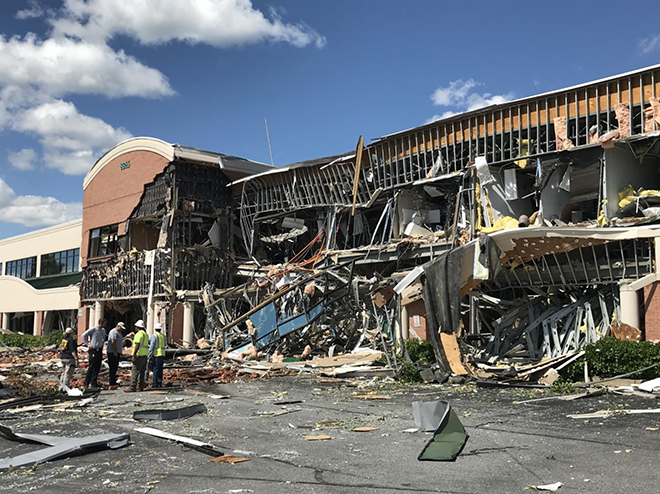Maryland utility inspectors concluded that Baltimore Gas and Electric Co.'s failure to adequately separate underground electric cables and natural gas service lines likely caused a 2019 office building explosion.
The finding prompted the company to redesign 250 facilities that had similar layouts.
Engineering staff at the Public Service Commission of Maryland, or PSC, found in an Aug. 6 report that the placement of electric cables and gas lines in close proximity violated state and federal safety rules, Maryland utility code, and industry standards. The staff recommended that commissioners levy fines on Baltimore Gas and Electric, or BGE, and order the company to take corrective actions.
The staff said it does not know to what extent the defect exists in other so-called joint trench installations on BGE's system. Investigators advised commissioners to require BGE to conduct excavations in order to determine the extent of the "unsafe condition."
The Aug. 25, 2019, gas explosion in Columbia, Md., occurred on a Sunday when offices and retail shops were closed and did not result in any fatalities. Source: Public Service Commission of Maryland
|
In a response to the report, BGE said it has identified 250 locations with designs similar the one at 8865 Stanford Blvd. in Columbia, Md., where a gas explosion on Aug. 25, 2019, tore through the office and retail space. The Exelon Corp. subsidiary is redesigning all of the locations and anticipated the work will be completed in 2021.
"We are reviewing the PSC Engineering Department's report and we intend to work closely with the PSC to address the issues in the report," BGE said in an email. "Based on our analysis of the Stanford Blvd. incident, BGE is currently instituting a number of changes to enhance the BGE system."
PSC staff identifies probable cause
During its investigation, PSC staff found that BGE electric and gas infrastructure and deactivated internet cables were in close proximity or crossed one another within a shared trench in the building. The investigators also discovered evidence of an electrical fault in a BGE electric service cable, burns in electric cables, and holes and other damage on a BGE plastic gas service line.
The PSC staff determined the probable cause of the explosion was an electrical cable fault that caused thermal degradation — or damage from overheating — in the nearby plastic gas service line. The deterioration of the service line allowed gas to escape into the building, where it ignited upon contact with an unknown ignition source, the staff concluded.
The staff said "a quality control inspection process should have prevented the installation defects that have been discovered in this investigation."
A "conclusion to date" provided by BGE dovetails with the PSC staff's probable cause finding. However, the company said, "experts have not yet been able to determine a way to safely simulate the event to aid in a complete understanding of the event."
PSC staffers suggested they were compelled to release their own report after the company's latest response on July 1 did not include new information since its last response Feb. 24. "Currently almost a year after the accident, BGE is unable to provide a more detailed root cause analysis of what triggered the event or accurately estimate a date of completion at this time," staff said.
Investigators recommend corrective actions, fines
BGE's planned redesigns included placing electric cables and gas lines in separate trenches and installing curb valves and enhanced conduit seal-offs for electrical ducts. "This work will ensure the safe and reliable operation of the BGE system so that an event like Stanford Blvd. does not happen again," BGE said.
However, PSC staff advised commissioners to order BGE to propose a corrective action plan within 60 days, including a plan for joint trench site inspections. Inspectors also recommended that BGE analyze its quality control processes for joint trench installations and consider whether they warrant improvement.
While the commission's staff concluded that there are no federal regulations or national standards that address the separation of electric cables and gas lines, the staff noted that federal pipeline safety code requires utilities to follow their own internal plans, procedures and programs. The staff said BGE's internal underground construction standards specify 12 inches of horizontal separation between facilities, reflecting a National Electric Safety Code, or NESC, standard that was in place during the construction of 8865 Stanford Blvd. The Code of Maryland Regulations also requires utilities to follow the latest NESC standards, the PSC staff said.
The staff recommended that commissioners order BGE to explain why it should not impose the maximum civil penalty of $218,647 for the alleged violations. Federal pipeline safety regulations prescribe a potential penalty of $218,647 for each violation for each day the violation continues, up to a maximum administrative civil penalty that will not exceed $2.19 million for a related series of violations.




